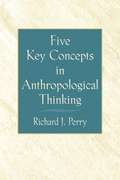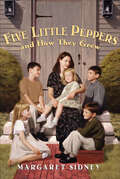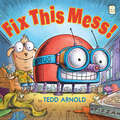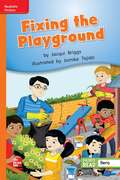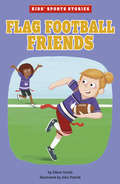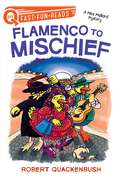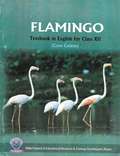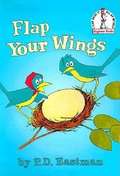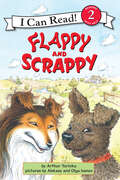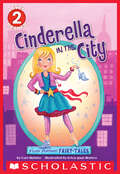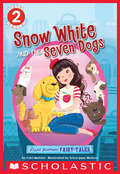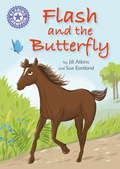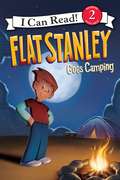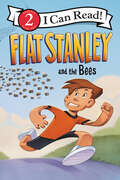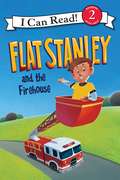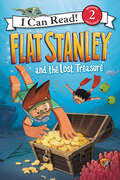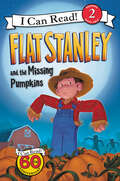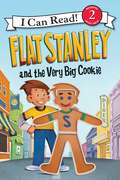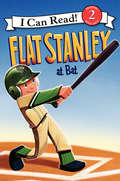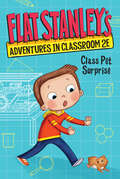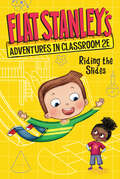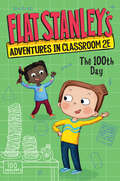- Table View
- List View
Five Key Concepts in Anthropological Thinking
by Richard J. PerryThis highly readable introduction discusses anthropological theory in a manner accessible to lay readers, yet does not oversimplify the material. Addresses five key concepts--evolution, culture, structure, function, and relativism--rather than individual theorists, and conveys the sense that their theory and associated debates can be interesting despite their complexity. Presents a balanced view of varying theoretical positions to pique readers' interest and avoid confusion. Uses clear, straightforward language, avoiding esoteric jargon. Critiques certain theoretical positions, including 19th-century racist theories and contemporary post-structural and postmodernist approaches. Includes a glossary of key terms that are highlighted throughout. A thought-provoking reference for anyone interested in learning about anthropology.
Five Little Peppers and How They Grew: Large Print
by Margaret SidneyMrs. Pepper and her five lively children Ben, Polly, Joel, Davie, and Phronsie have had many hard times in the Little Brown House since the children's father died. But no matter how tough things get, the Little Peppers always handle their difficulties with great courage and cheer. They have learned to take delight even in the smallest of pleasures because the children are sure that good times are just around the corner. One day, the Peppers meet a wealthy gentleman and his young son who will change their lives forever. Could this finally be the beginning of the good times the Little Peppers have been waiting for?
Fix This Mess! (I Like to Read)
by Tedd ArnoldA funny story about a boy, a robot, and a BIG, BIG mess! This Level D book is perfect for kindergarten readers. From the creator of the widely popular Fly Guy books! "Fix this mess!" Jake tells Robug. But Robug just makes things worse. Robug finally figures out how to fix the mess—but it's not what Jake expected. Tedd Arnold's illustrations of Robug's frantic efforts are laugh-out-loud funny, as Robug tries again and again to fix the mess—stirring up clouds of dust, old pizza boxes, and banana peels, and leaving Jake's cat more and more confused as he bounces from the couch to the top of the television. Fix This Mess! is an International Literacy Association-CBC Children&’s Choice The award-winning I Like to Read® series focuses on guided reading levels A through G, based upon Fountas and Pinnell standards. Acclaimed author-illustrators--including winners of Caldecott, Theodor Seuss Geisel, and Coretta Scott King honors—create original, high quality illustrations that support comprehension of simple text and are fun for kids to read with parents, teachers, or on their own! Suitable for late kindergarten readers, Level D books feature wider vocabulary, longer sentences, and greater variety in sentence structure than Levels A, B, and C. When Level D is mastered, follow up with Level E.
Fixing the Playground [Approaching Level, Grade 2]
by Jacqui Briggs Jomike TejidoNIMAC-sourced textbook
Flag Football Friends (Kids' Sports Stories)
by Elliott SmithRiley and Jada click in any sport they play. This summer, it's flag football, and they can't wait to play wide receiver and quarterback. But Coach thinks Riley's better at center and splits up the duo, shaking Riley's confidence. It'll take a special play for her to step up and shine.
Flamenco to Mischief: A QUIX Book (A Miss Mallard Mystery)
by Robert QuackenbushWorld-famous duck-tective Miss Mallard tracks down a stolen painting in Spain in this engaging Aladdin QUIX mystery.While on holiday in sunny Spain to attend a flamenco festival, Miss Mallard, the world-famous ducktective, and her nephew Willard Widgeon of the Swiss police become involved with intrigue. A painting by Miss Mallard&’s great friend, El Ducko, Spain&’s wealthiest artist, is stolen. Miss Mallard goes undercover as a flamenco dancer to &“quack&” the case.
Flamingo (Core Course) class 12 - S.C.E.R.T Raipur - Chhattisgarh Board
by Raipur C. G. Rajya Shaikshik Anusandhan Aur Prashikshan ParishadThis textbook of English is called 'Flamingo'. It has been published for the students of class XII of humanities/arts/science/commerce streams who have chosen English core or English ‘A’. This textbook is designed for an interesting and innovative journey of learning of English literature and is prescribed in Private as well as in Public schools. This English textbook is in accordance with school’s syllabus and also helps students to prepare for CBSE Boards
Flamingo Supplementary Reader (English Second Language) class 11 - GSTB
by Gujarat State School Textbook BoardThe "Flamingo Supplementary Reader" for 11th grade English (Second Language), published by the Gujarat State School Textbook Board, provides students with a variety of engaging and diverse reading materials aimed at enhancing their English proficiency. It features a collection of stories, folk tales, poems, and moral lessons designed to promote both language development and critical thinking. The supplementary reader complements the main textbook by encouraging self-learning, creative thinking, and reading for pleasure. Through relatable content and exercises, it helps students develop comprehension, expand their vocabulary, and improve their language skills. The reader also focuses on real-life applications of English and aims to support students in excelling at national and international levels, particularly in competitive exams.
Flap Your Wings (Beginner Books(R))
by P. D. EastmanWhen a strange egg appears in their nest, Mr. and Mrs. Bird kindly take it upon themselves to raise the "baby bird" inside. But when the egg hatches, the Birds are in for a big surprise--"Junior" is the oddest-looking baby bird they've ever seen--with big, longjawsfull of teeth and an appetite to match. In fact, he looks more like a babyalligatorthan a baby bird! Nevertheless, the devoted Birds run themselves ragged feeding Junior until he gets so big, he must leave the nest or it will collapse underneath him. But how can Junior fly without wings? To the delight of the Birds--and readers!--the dilemma is solved when Junior takes off from a branch overlooking a pond.
Flappy and Scrappy (I Can Read Level 2)
by Arthur YorinksFlappy and Scrappy are friends - the kind who know just what to say when one feels sad. They′re the kind of friends who will play even when they don′t really want to, just to make the other happy. The kind who never forget a birthday. What kind of friends are they? Best friends.These three easy-to-follow stories about friendship will delight beginning readers everywhere.
Flash Forward Fairy Tales: Cinderella in the City (Scholastic Reader, Level 2)
by Cari MeisterModern fairy tales for modern kids!Once upon a time, Cinderella longed to go to the ball, marry a prince, and become a princess. But that was then. Flash forward to today....Cinderella wants to to enter an awesome new dance contest more than anything. But she's got a ton of chores, an annoying family, and nothing to wear! Good thing she's also got a Blackberry-wielding fairy godmother! With some new glas slippers and a few slick moves, Cindy may just dance her way into a whole new life and live happily ever after!
Flash Forward Fairy Tales: Snow White and the Seven Dogs (Scholastic Reader, Level 2)
by Cari MeisterModern fairy tales for modern kids!Once upon a time, Snow White fled from an evil queen and found peace in the forest with seven dwarves. But that was then. Flash forward to today....Snow White can't help being the prettiest thing in her stepmother's chic boutique. But when awful Evilyn notices, she banishes Snow forever. It's a good thing the mall is full of strange and wonderful creatures, because soon Snow finds a home with seven tiny dogs who save her from poison and help her live happily ever after!
Flash and the Butterfly: Independent Reading Purple 8 (Reading Champion #182)
by Jill AtkinsFlash is a young foal who likes to explore. His mother warns him not to go too far away, but when he spots a beautiful butterfly, he has to follow it, no matter where he ends up! Reading Champion offers independent reading books for children to practise and reinforce their developing reading skills.Fantastic, original stories are accompanied by engaging artwork and a reading activity. Each book has been carefully graded so that it can be matched to a child's reading ability, encouraging reading for pleasure. Perfect for 5-7 year olds or those reading book band 8.
Flashfoot Meets Shredzone (Fountas & Pinnell Classroom, Guided Reading)
by John Lee Kim GriswellNIMAC-sourced textbook. 720 McTwist. Drew's been struggling to land a 720 McTwist for weeks. No one else can do it—and then a new kid nails it on his first try.
Flat Stanley Goes Camping (I Can Read Level 2)
by Jeff BrownElementary-school kids love Jeff Brown’s classic character, Flat Stanley—the amazing paper-thin boy who can slide under doors, fly like a kite, and travel by mail.In his latest fun-filled adventure, Flat Stanley Goes Camping, Stanley and the Lambchop family take a trip to the woods. It gets a little scary when Stanley and his brother, Arthur, run away from a skunk—and straight toward the edge of a cliff!Flat Stanley Goes Camping is an I Can Read book designed to engage and excite child readers. It is a Level 2 book, which means it is perfect for kids who are starting to read on their own but still need some help.
Flat Stanley and the Bees (I Can Read Level 2)
by Jeff BrownBeing flat sure makes it fun for Flat Stanley when playing backyard games with his pals—but not when bees are chasing them! Join Stanley in his newest adventure. On a hot summer day, Flat Stanley and his friends have lots of fun games to play. Stanley’s flatness comes in handy, especially during hide-and-seek. But when the fun disrupts a beehive, can Stanley save his buddies before the bees get them?Beginning readers will love how Flat Stanley gets out of a sticky situation to save the day...with the help of his mom’s honey buns!Flat Stanley and the Bees is a Level Two I Can Read book, geared for kids who read on their own but still need a little help. Whether shared at home or in a classroom, the engaging stories, longer sentences, and language play of Level Two books are proven to help kids take their next steps toward reading success.
Flat Stanley and the Firehouse (I Can Read Level 2)
by Jeff BrownStanley’s Stop, Drop, and Roll poster wins him a trip to the firehouse, but the visit takes an unexpected turn in this Flat Stanley I Can Read adventure! Stanley is elated. His Stop, Drop, and Roll poster won the Fire Safety Month contest. Stanley's prize is a trip to the firehouse! When Chief Abbot invites him to climb onto a real fire truck, Stanley thinks things can't get any better, but the visit takes an even more exciting turn.Beginning readers will love following along with Stanley's exciting rescue mission. Sometimes flatter is better!Flat Stanley and the Firehouse is a Level Two I Can Read book, geared for kids who read on their own but still need a little help.
Flat Stanley and the Lost Treasure (I Can Read Level 2)
by Jeff BrownIn this latest Flat Stanley I Can Read adventure, Stanley goes on a snorkeling adventure and makes a dazzling discovery—sunken treasure!Sometimes being flat comes in handy for Flat Stanley—like when he is surfing or rescuing a trapped dolphin from a net. In this exciting adventure, Flat Stanley and his brother, Arthur, find sunken treasure in an old shipwreck. But Stanley has to get rid of his gold bar in order to squeeze through the net and rescue the dolphin. Will they ever find the treasure again?Flat Stanley and the Lost Treasure is a Level Two I Can Read book, geared for kids who read on their own but still need a little help.
Flat Stanley and the Missing Pumpkins (I Can Read Level 2)
by Jeff BrownIn this Flat Stanley I Can Read adventure, Stanley visits his relatives at the farm and helps his uncle win big at the pumpkin contest!There are so many fun ways for Flat Stanley to help on his uncle’s farm in the fall. Being flat comes in handy when picking corn and even acting like a scarecrow! But when pumpkins begin to disappear right before the county fair, will Flat Stanley be able to help? Flat Stanley and the Missing Pumpkins is a is a Level Two I Can Read book, geared for kids who read on their own but still need a little help.
Flat Stanley and the Very Big Cookie (I Can Read Level 2)
by Jeff BrownBeginning readers will love following along with Flat Stanley’s yummiest I Can Read adventure yet!Flat Stanley loves to help Mr. Pete the Baker make his delicious treats! When another baker begins taking away all his business, Mr. Pete comes up with a BIG idea to save his bakery, but he needs help from Stanley and Arthur! Will they succeed or will everything just fall flat? Flat Stanley and the Very Big Cookie is a Level Two Can Read book, geared for kids who read on their own but still need a little help.
Flat Stanley at Bat (I Can Read Level 2)
by Jeff BrownFlat Stanley, the beloved character created by Jeff Brown, is back in this fun I Can Read book about baseball! When Stanley plays center field for his baseball team, he is a flat-out great player! None of the other players can float to catch the highest hits, or earn walks from the fastest pitchers. But when the fairness of his flatness is questioned by the other team, Stanley has to step up to bat to prove himself. Flat Stanley at Bat is a Level 2 I Can Read book, geared toward kids who can read on their own but still need a little help. Whether shared at home or in a classroom, the engaging stories, longer sentences, and language play of Level Two books are proven to help kids take their next steps toward reading success.
Flat Stanley's Adventures in Classroom 2E #1: Class Pet Surprise (Flat Stanley's Adventures in Classroom2E #1)
by Jeff Brown Kate EganBeloved character Flat Stanley is back with a whole new set of friends in this brand-new STEM-focused chapter book series. In this first book, Stanley’s class gets an adorable class pet, plus a crash course on animal life and engineering!Ever since Stanley Lambchop was flattened by a bulletin board, each day brings new adventures!Stanley’s second grade teacher, Ms. Root, loves science, and she has an exciting surprise in store for the class: they’re getting a pet! Stanley and his classmates can’t wait to play with their adorable hamster, Cottonball, and learn all about animal life.But then Cottonball escapes! Stanley and his best friend, Marco, have some ideas on what to do to find her, but they’ll need to work through their disagreements and overcome engineering roadblocks to construct the best solutions for Cottonball. Will classroom 2E be able to catch her? And how will they keep her from escaping again?Featuring adorable black & white illustrations, an accessible approach to STEM topics, and fun facts about wild hamsters in the backmatter. Don’t miss any of Flat Stanley’s classroom adventures!
Flat Stanley's Adventures in Classroom 2E #2: Riding the Slides (Flat Stanley's Adventures in Classroom2E #2)
by Jeff Brown Kate EganBeloved character Flat Stanley is back with a whole new set of friends in this brand-new STEM-focused chapter book series. In this second book, Stanley and his friends learn all about the scientific method, gravity, and friction through a heated contest on the playground! Ever since Stanley Lambchop was flattened by a bulletin board, each day brings new adventures!According to Stanley’s second grade teacher, Ms. Root, everyone in classroom 2E is a scientist. That’s good news for Stanley because he has a problem in need of solving! Both his classmate, Josie, and his little brother, Arthur, think he’s been using his flatness to cheat during playground games. But Stanley can’t help being flat!It’s time to test how flatness affects Stanley on the playground. Will science be on his side?Featuring adorable black & white illustrations, an accessible approach to STEM topics, and a fun experiment in the backmatter for readers to try themselves. Don’t miss any of Flat Stanley’s classroom adventures!
Flat Stanley's Adventures in Classroom 2E #3: The 100th Day (Flat Stanley's Adventures in Classroom2E #3)
by Jeff Brown Kate EganBeloved character Flat Stanley is back with a whole new set of friends in this STEM-focused chapter book series. In the third book, Stanley must calculate the perfect number of treats to bring to Classroom 2E’s hundredth day of school celebration.Ever since Stanley Lambchop was flattened by a bulletin board, each day brings new adventures!It’s the hundredth day of school, and the second graders in Classroom 2E will each be bringing in one hundred of something to celebrate. Stanley knows exactly what he wants to bring—flat pancakes. But the number of people coming to the party keeps changing!Stanley must add, subtract, and multiply his way to the perfect treat for the Hundredth Day of School bash. Will he get the numbers right?Featuring adorable black & white illustrations, an accessible approach to STEM topics, and a fun recipe for readers to try themselves. Don’t miss any of Flat Stanley’s classroom adventures!
